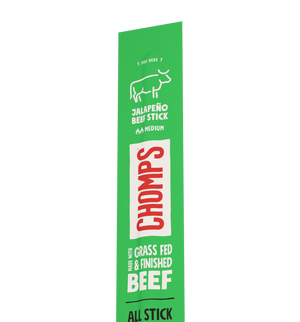Typical farming methods used today are designed to produce more crops at a faster rate, but they come at a cost. The types of farming practices developed after the Industrial Revolution are not sustainable long term. They can cause damage to our environment, lessen the nutritional value of our food, and affect our overall health.
Here at Chomps, we support more sustainable farming practices that yield a positive environmental impact and enhanced nutrition. A more sustainable farming practice called regenerative agriculture or regenerative farming has been gaining the attention of eco-conscious farmers for its wide-ranging benefits.
What is regenerative agriculture? What are its benefits, and how can you know if your food is grown in this manner? Keep reading to find out!
What is Regenerative Farming?
Regenerative farming or regenerative agriculture is farming in harmony with nature. It is a holistic approach to agriculture that encourages the interconnection between farming and the ecological system as a whole.
Regenerative farming principles are based on the overarching goal to create more sustainable farming practices that protect our land, food supply, and local communities as much as possible.
In stark contrast, traditional farming methods after the Industrial Revolution increased soil erosion at an alarming rate, resulting in spillage of nutrients into coastal systems, the creation of excess algae in coastal waters called algal blooms, and threats to biodiversity and the global environment as a whole.
These traditional systems are not efficient or health-conscious and focus mainly on the yields of individual crops, not on how all aspects of farming can merry together.
The key principles of regenerative agriculture are based on pre-industrialized farming practices. These principles are intended to work with the world’s natural resources that are available and utilize them, rather than working against them.
Principles of Regenerative Agriculture
Here are the 5 key principles a regenerative farming system lives by:
-
Minimize soil disturbances
In regenerative agriculture, tilling of the soil is minimized to reduce the risk of any physical, biological, or chemical soil disturbances.
2. Keep the soil covered
To protect the soil further, the focus is on keeping the soil covered with natural materials from mulching, cover crops, and pastures, increasing soil health.
3. Increase plant diversity
Promoting a diverse array of plants will build healthy soils that increase water retention and nutrients. This is also beneficial for other wildlife or pollinators such as bees, butterflies, and birds.
4. Keep living roots in the soil
Keeping living roots in the soil helps retain excess water and prevents nutrient runoff. Nutrient runoff is when excess nutrients spill out from the soil into bodies of water, creating an overproduction of algae detrimental to marine life.
5. Integrate animals into farm practices
The manure produced by farm animals adds valuable nutrients to the soil and acts as a natural fertilizer, reducing the need for more potent, synthetic fertilizers.
Chomps supports these principles because we believe in the production of a more nutritious, safe food supply that also reduces our carbon footprint.
Benefits of Regenerative Agriculture Practices
Regenerative farming not only offers multiple health and environmental benefits, but it also offers community and economic benefits.
Environmental Benefits
Regenerative agriculture yields significant environmental benefits, which ultimately improve soil conditions for a more nutrient-rich food production.

Improves soil health and fertility
Regenerative farming practices yield soil that retains more water and nutrients and promotes carbon cycling. This results in improved soil quality, increased yields, and better crop health.
Improves biodiversity
This is the case on both land and in the soil, which promotes richer plant, bird, and insect populations.
Reduces soil erosion
Keeping living roots in the soil helps to retain water in the ground, improves soil health, and thus reduces erosion.
Reduces water pollution
This includes the risk of harmful algal blooms that back up in the ocean and pose a risk to marine life. This reduction in algal blooms is because there are fewer chemical pesticides being used.
Diminishes the effect of climate change
With more efficient land management practices, regenerative agriculture has the potential to reduce greenhouse gas emissions and may help to pull excess carbon dioxide out of the atmosphere.
Community Benefits
Regenerative agriculture benefits the community as a whole as well, as it helps foster closer relationships between farmers and consumers who share the same goals, strengthening food security and fighting the climate crisis. .
Expands farmers networks
Supports a network of growers who share information, build a closer community, and learn from one another.
Creates a more robust network of farmer’s markets
This helps farmers encourage stronger relationships between consumers and their food by them being out in their local community and farmers’ market stands.
Health Benefits
Perhaps one of the biggest benefits of regenerative land management practices is its benefits to health.
Produces more nutritious food
Research shows food grown under regenerative farming practices contained more vitamins and minerals and less harmful ingredients such as sodium, cadmium, and nickel compared to those conventionally grown. Food grown in this manner is also more sustainable.
Creates more joyful farmers
Regenerative agriculture farmers report feeling joy as a result of the type of work they do.
Reduces exposure to harmful chemicals
Farmers, farmworkers, and consumers benefit from the reduced use of harmful chemicals using regenerative agriculture practices.
Economic Benefits
Regenerative agriculture also supports a thriving economy in several ways.
Saves costs
Provides cost savings from the reduced use of antibiotics and synthetic fertilizers, herbicides, and pesticides and the use of natural fertilizers such as livestock manure.
Provides a financial safety net
Offers financial security from diversified revenue streams associated with these farm management practices.
Serves the local economy
Promotes the local economy by offering local employment and making healthier food choices more accessible to all.
CHOMPS Supports Regenerative Farm Practices
At Chomps, our ultimate mission is to source our meat stick ingredients from the highest quality farms around the world. For this reason, we choose farmers who practice regenerative agriculture methods that preserve grass and soil quality, so the animals and environment benefit the most.
Because of this our meat snacks are made with only the highest quality proteins free from antibiotics, hormones, or synthetic chemicals.
Shop our complete selection of Chomps meat snacks here and stock up on nutritious snacks from farmers you can trust.
































